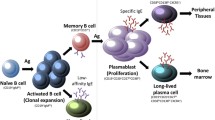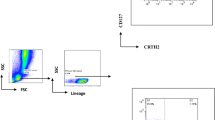Abstract
Background
Recent studies have shown the importance of Th17 cells in the development of allergic airway diseases. We examined Dermatophagoides pteronyssinus-induced changes in peripheral blood Th17 cells to establish the importance of these cells in late-phase allergic inflammation in patients with allergic rhinitis (AR) and allergic asthma (AA).
Methods
Eighteen patients with mild-to-moderate/severe persistent AR, 14 patients with intermittent- or mild-to-moderate persistent AA, and 15 healthy subjects (HS) were examined. All patients had positive skin test to D. pteronyssinus. Study subjects underwent bronchial challenge with D. pteronyssinus. The peripheral blood Th1, Th2, and Th17 cells were determined by flow cytometry 24 h before and 7 and 24 h after challenge. The serum IL-17 levels were determined by ELISA.
Results
The percentage of Th17 cells and IL-17 levels was significantly higher in patients with AR and AA compared with HS before and after challenge. Twenty-four hours after challenge, the percentage of Th17 cells increased significantly in patients with AA compared with baseline values. The IL-17 levels rose markedly in patients with AR and AA after challenge. Moreover, 24 h after challenge, the percentage of Th17 cells and IL-17 levels were significantly higher in patients with AA than those with AR.
Conclusions
Percentages of peripheral blood Th17 cells and serum IL-17 levels were found to be higher in patients with AR and AA. An increase in the percentage of Th17 cells following challenge shows that Th17 cells may have an important role in the development of late-phase allergen-induced inflammation.






Similar content being viewed by others
References
Devendra K, Shao AZ (2010) Pathogenesis of allergic airway inflammation. Curr Allergy Asthma Rep 10:39–48
Fischer R, Tome D, McGhee JR, Boyaka PN (2007) Th1 and Th2 cells are required for both eosinophil- and neutrophil-associated airway inflammatory responses in mice. Biochem Biophys Res Commun 357:44–49
Mazzarella G, Bianco A, Catena E, De Palma R, Abbate GF (2000) Th1/Th2 lymphocyte polarization in asthma. Allergy 55(Suppl 61):6–9
Schmidt-Weber CB, Akkdis M, Akkdis CA (2007) Th17 cells in the big picture of immunology. J Allergy Clin Immunol 120:247–254
Shen H, Goodall JC, Hill Gaston JS (2009) Frequency and phenotype of peripheral blood Th17 cells in ankylosing spondylitis and rheumatoid arthritis. Arthritis Rheum 60(6):1647–1656
Toosi S, Bystryn JC (2010) Potential role of interleukin-17 in the pathogenesis of bullous pemphigoid. Med Hypotheses 74(4):727–728
Ishizu T, Osoegawa M, Mei F-J, Kikuchi H, Tanaka M, Takakura Y, Minohara M, Murai H, Mihara F, Taniwaki T, Kira J (2005) Intrathecal activation of the IL-17/IL-8 axis in opticospinal multiple sclerosis. Brain 128:988–1002
Durrant DM, Gaffen SL, Riesenfeld EP, Irvin CG, Metzger DW (2009) Development of allergen-induced airway inflammation in the absence of T-bet regulation is dependent on IL-17. J Immunol 183(8):5293–5300
Wakashin H, Hirose K, Maezawa Y, Kagami S, Suto A, Watanabe N, Saito Y, Hatano M, Tokuhisa T, Iwakura Y, Puccetti P, Iwamoto I, Nakajima H (2008) IL-23 and Th17 cells enhance Th2-Cell-mediated eosinophilic airway inflammation in mice. Am J Respir Crit Care Med 178:1023–1032
Sun Y, Zhou Q, Yao W (2005) Sputum interleukin-17 is increased and associated with airway neutrophilia in patients with severe asthma. Chin Med J 118:953–956
Wilson RH, Whitehead GS, Nakano H, Free ME, Kolls JK, Cook DN (2009) Allergic sensitization through the airway primes Th17-dependent neutrophilia and airway hyperresponsiveness. Am J Respir Crit Care Med 180:720–730
Bullens DMA, Truyen E, Coteur L, Dilissen E, Hellings PW, Dupont LJ, Ceuppens JL (2006) IL-17 mRNA in sputum of asthmatic patients: linking T cell driven inflammation and granulocytic influx? Respir Res 7:135–143
Bousquet J, Khaltaev N, Cruz AA, Denburg J, Fokkens WJ, Togias A et al (2008) Allergic rhinitis and its impact on asthma (ARIA) 2008 update (in collaboration with the WHO, GA2LEN and AllerGen). Allergy 63(Suppl 86):8–160
Global initiative for asthma (GINA) (2002). Global strategy for asthma management and prevention: NHLBI/WHO workshop report. Bethesda: National Institutes of Health, National Heart, Lung and Blood Institute. Revised 2002. http://www.ginasthma.org/
Dreborg S, Backman A, Basoma A (1989) Skin tests used in type I allergy testing. Position paper. Allergy 44(Suppl 10):1–59
Miller MR, Hankinson J, Brusasco V, Burgos F, Casaburi R, Coates A (2005) ATS/ERS task force standardisation of lung function testing. Standardisation of spirometry. Eur Respir J 26:319–338
Baur X, Huber H, Degens PO, Allmers H, Ammon J (1998) Relation between occupational asthma case history, bronchial methacholine challenge, and specific challenge test in patients with suspected occupational asthma. Am J Ind Med 33:122–144
Liu L, Jarjour NN, Busse WW, Kelly EAB (2007) Enhanced generation of helper T type 1 and 2 chemokines in allergen-induced asthma. Am J Respir Crit Care Med 169:1118–1124
Ravensberg AJ, van Rensen ELJ, Grootendorst DC, de Kluijver J, Diamant Z, Ricciardolo FLM, Sterk PJ (2007) Validated safety predictions of airway responses to house dust mite in asthma. Clin Exp Allergy 37:100–107
Van Der Veen MJ, Jansen HM, Aalberse RC, van der Zee JS (2001) Der p 1 and Der p 2 induce less severe late asthmatic responses than native Dermatophagoides pteronyssinus extract after a similar early asthmatic response. Clin Exp Allergy 31(5):705–714
Sitkauskiene B, Johansson AK, Sergejeva S, Lundin S, Sjöstrand M, Lötvall J (2004) Regulation of bone marrow and airway CD34+ eosinophils by interleukin-5. Am J Respir Cell Mol Biol 30:367–378
Pene J, Chevalier S, Preisser L, Vanereau E, Guileux MH, Ghannm S, Moles JP, Danger Y, Ravon E, Lesaux S, Yssel H, Gascan H (2008) Chronically inflamed human tissues are infiltrated by highly differentiated Th17 lymphocytes. J Immunol 180:7423–7430
Ciprandi G, Filaci G, Battaglia F, Fenoglio D (2010) Peripheral Th-17 cells in allergic rhinitis: new evidence. Int Immunopharmacol 10:226–229
Hashimotoa T, Akiyamaa K, Kobayashib N, Moria A (2005) Comparison of IL-17 production by helper T cells among atopic and nonatopic asthmatics and control subjects. Int Arch Allergy Immunol 137:51–54
Zhao Y, Yang J, Gao Y, Guo W (2010) Th17 immunity in patients with allergic asthma. Int Arch Allergy Immunol 151:297–307
Miossec P, Korn T, Kuchroo VK (2009) Interleukin-17 and type 17 helper T cells. N Engl J Med 361:888–898
Wong CK, Ho CY, Ko FW, Chan CH, Ho AS, Hui DS, Lam CW (2001) Proinflammatory cytokines (IL-17, IL-6, IL-18, and IL-12) and Th cytokines (IFN-γ, IL-4, IL-10 and IL-13) in patients with allergic asthma. Clin Exp Immunol 125:177–183
Henness S, Thoor E, Ge Q, Armour CL, Hughes JM, Ammit AJ (2006) IL-7A acts via p38 MAPK to increase stability of TNF-α-induced IL-8 mRNA in human ASM. Am J Physiol Lung Cell Mol Physiol 290:L1283–L1290
Ciprandi G, De Amici M, Murdaca G, Fenoglio D, Ricciardolo F, Marseglia G, Tosca M (2009) Serum interleukin-17 levels are related to clinical severity in allergic rhinitis. Allergy 64:1375–1378
Agache I, Ciobanu C, Agache C, Anghel M (2010) Increased serum IL-17 is an independent risk factor for severe asthma. Respir Med 104:1131–1137
Holgate ST, Polosa R (2006) The mechanisms, diagnosis and management of severe asthma in adults. Lancet 368:780–793
Kawayama T, O’Byrne PM, Watson RM, Killian KJ, Duong M, Yoshida M, Gauvreau GM (2006) Effects of inhaled ciclesonide on circulating T-helper type 1/T-helper type 2 cells in atopic asthmatics after allergen challenge. Clin Exp Allergy 36(11):1417–1424
Akdis M, Verhagen J, Taylor A, Karamloo F, Karagiannidis Ch, Crameri R, Thunberg S, Deniz G, Valenta R, Fiebig H, Kegel C, Disch R, Schmidt-Weber CB, Blaser K, Akdis CA (2004) Immune responses in healthy and allergic individuals are characterized by a fine balance between allergen-specific T regulatory 1 and T helper 2 cells. J Exp Med 199(11):1567–1575
Acknowledgments
This research was funded by a Grant (No. LIG-18/2010) from the Research Council of Lithuania. The authors thank Prof. Dr. Brigita Sitkauskiene for her critical reading of this article.
Conflict of interest
The authors declare that they have no conflict of interests.
Author information
Authors and Affiliations
Corresponding author
Rights and permissions
About this article
Cite this article
Bajoriuniene, I., Malakauskas, K., Lavinskiene, S. et al. Response of Peripheral Blood Th17 Cells to Inhaled Dermatophagoides pteronyssinus in Patients with Allergic Rhinitis and Asthma. Lung 190, 487–495 (2012). https://doi.org/10.1007/s00408-012-9411-y
Received:
Accepted:
Published:
Issue Date:
DOI: https://doi.org/10.1007/s00408-012-9411-y




